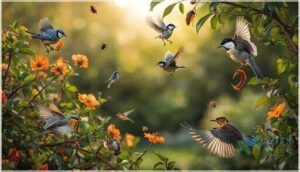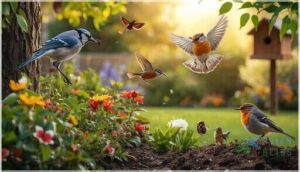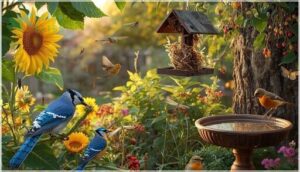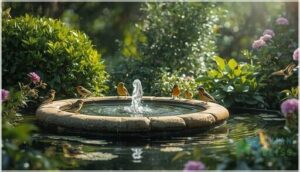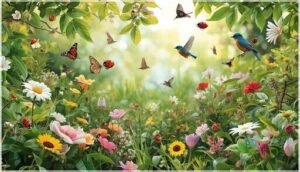This site is supported by our readers. We may earn a commission, at no cost to you, if you purchase through links.

Every spring, your garden hums with hidden activity, but a few winged helpers turn the tables on the bugs beneath your flowers. Look closely: bluebirds and chickadees dart from branches, snapping up beetles and grasshoppers before you’ve even noticed there’s a problem.
Attracting insect-eating birds isn’t about luck or waiting for nature to act—it’s about giving these feathered pest controllers the invitation they’ve been waiting for. With the right habitat and a few gentle changes, you can turn your yard into a safe haven where birds feast, pests dwindle, and the whole landscape buzzes with real purpose.
Table Of Contents
- Key Takeaways
- Which Birds Eat Insects in Your Garden?
- Why Attract Insect-Eating Birds?
- Food Sources to Attract Bug-Eating Birds
- Creating a Bird-Friendly Habitat
- Tips for Long-Term Bird Attraction
- Frequently Asked Questions (FAQs)
- How can I attract insect-eating birds to my yard?
- How do you attract birds that eat small flying insects?
- How do you attract birds that eat spiders?
- How to attract avian insect hunters?
- How to attract birds to your garden?
- How to attract insects for birds?
- How to attract birds that eat mosquitoes?
- How to attract fly catcher birds?
- What do you feed insects eating birds?
- How do you encourage insects to eat birds?
- Conclusion
Key Takeaways
- Attract insect-eating birds by planting native trees and shrubs, adding water sources, and providing safe nesting spots.
- Skip pesticides and let your garden develop natural insect diversity to feed visiting birds and keep ecosystems healthy.
- Offer high-protein foods like mealworms and suet, especially during winter, to help birds thrive when insects are scarce.
- Keeping cats indoors and maintaining a diverse, shelter-rich landscape makes your yard a safe haven for birds and boosts natural pest control.
Which Birds Eat Insects in Your Garden?
Many birds in your yard are natural bug hunters, each with their own favorite snacks. If you’re curious about which species help keep pests in check, you’re in the right place.
Here’s a closer look at the birds that eat insects and what they go after.
Common Insect-Eating Bird Species
Curiosity about bird behavior often leads to delightful discoveries in your garden. You’ll spot insect-eating birds like:
- Bluebirds and chickadees, known for their helpful nesting habits and feather care routines.
- Swallows, masters of bird migration, gliding through the air.
- Robins and woodpeckers, busy at work attracting birds to your garden while keeping insect pests in check.
Bird watching never gets old! Understanding insect populations is key to creating a balanced ecosystem.
What Insects Do These Birds Eat?
If you watch insect-eating birds in your yard, you’ll notice their bug diversity is impressive. Bluebirds and cardinals target beetle consumption and grasshoppers. Swallows snap up fly species and mosquitoes. Chickadees prefer a caterpillar diet, plus ants and earwigs. Each species has its own insect preferences, helping control garden pests and keeping your bird-friendly space balanced and lively.
By incorporating native plants that attract bird friendly bugs, you can create a thriving ecosystem that sustains a wide range of bird species.
Seasonal Patterns of Insect Consumption
As insect-eating birds shift their diets through the year, you’ll see dramatic changes in their feeding. Warmer temperatures spark insect migration, boosting food for aerial insectivores and nestlings. During breeding cycles, birds rely heavily on bugs.
Seasonal feeding patterns in bird-friendly gardening include:
- Bird Diet Shifts in spring
- Temperature Effects on insect activity
- Natural pest control methods peak
- Insect Migration fuels migration routes
Why Attract Insect-Eating Birds?
Inviting insect-eating birds into your yard brings more than just cheerful songs. These helpful visitors offer real benefits for your garden and the environment.
Here’s what you can look forward to when you make your space welcoming for them.
Natural Pest Control Benefits
Imagine your garden as a living shield—beneficial garden birds, like swallows and wrens, devour hundreds of pests daily. This natural pest control means fewer mosquitoes, beetles, and caterpillars, saving you money and reducing chemical use.
Beneficial garden birds, like swallows and wrens, form a living shield by devouring pests and reducing the need for chemicals
Insect-eating birds boost garden pest control, support sustainable practices, and deliver economic benefits, all while keeping your bird-friendly gardening thriving.
Supporting Ecological Balance
Harmony thrives when you invite insect-eating birds into your bird-friendly garden. Their presence strengthens ecological balance by weaving together:
- Ecosystem Services—birds control pests and support plant health.
- Biodiversity Conservation—diverse bird species help maintain habitat resilience.
- Wildlife Preservation—restoring native vegetation boosts food and shelter for birds.
That’s how your garden becomes a living force for ecological resilience and wildlife conservation.
Enhancing Birdwatching Opportunities
Listening to the lively chatter of insect-eating birds brings your backyard to life. By attracting birds to your yard through smart garden design and bird-friendly gardening, you boost bird diversity and set the stage for fascinating bird behavior.
Increased bird activity draws eco-tourism interest and enhances both backyard bird watching and broader wildlife conservation, making every glance outdoors rewarding.
Food Sources to Attract Bug-Eating Birds
Regarding attracting bug-eating birds, what you offer for food makes all the difference. Some options work better than others, especially when you want these helpful visitors to stick around.
Here’s what you can try in your yard.
Offering Live and Dried Mealworms
Ever noticed how offering live and dried mealworms turns your yard into a magnet for insect-eating birds? Packed with protein and moisture, mealworms are nature’s power snack for bluebirds, robins, and chickadees.
Try these proven Bird Feeder Tips for successful Insect Supplementation:
- Store mealworms cool and dry
- Offer 10–15 daily per bird
- Use shallow feeders
- Soak dried mealworms for hydration
Providing High-Energy Suet Cakes
Nothing draws birds to feeders like suet cakes bursting with energy—a lifesaver for insect-eating birds in winter. Thanks to their high suet energy content and rich nutritional composition, species like woodpeckers and nuthatches flock to them.
Place feeders in cool, shaded spots for best results. Seasonal suet usage soars when bugs are scarce, making bird-friendly gardening remarkably simple.
Planting Insect-Attracting Native Plants
Picture your yard as a buffet—every native plant you add boosts insect diversity benefits for insect-eating birds. By choosing local plant sourcing and sustainable landscaping, you enrich your garden ecosystem health and attract more birds naturally.
- Plant native shrubs and perennials
- Mix in flowering natives
- Favor regionally indigenous species
- Shop local nurseries for native plants
Maintaining Natural Insect Populations
Think of your garden as a living web—each change you make cultivates a thriving insect population for insect-eating birds. Boost vegetation density and provide natural shelter to encourage beneficial insects. Skip harsh pesticides; gentle, natural pest control methods help maintain ecological balance.
Using mulch management and fostering landscape connectivity also help your space teems with natural bird food year-round.
Creating a Bird-Friendly Habitat
Turning your yard into a haven for insect-eating birds is easier than you might think. With a few thoughtful changes, you can make your garden their favorite spot.
Here’s what you’ll want to keep in mind as you shape a welcoming habitat.
Planting Native Trees and Shrubs
Native plant selection is your strongest tool for bird-friendly gardening. Shrub density makes a real difference—more shrubs mean more nesting habitat value and seasonal food sources for insect-eating birds.
Native trees and shrubs invite not just birds, but the insects they rely on, supporting year-round ecosystem health benefits. Every native you plant brings your yard closer to a thriving haven.
Providing Water Features and Moving Water
After setting out native shrubs, choosing the right water feature types adds another layer of welcome in your garden. Bird baths, outdoor fountains, and moving water sources don’t just draw attention—they multiply visits and boost bathing.
Keep water depth safe (1–2 inches), clean bird baths regularly, and think about winter water access to help birds thrive all year.
Offering Safe Nesting Sites and Shelter
After filling your yard with water features, choose safe nesting sites and shelter to truly welcome birds.
Install a birdhouse or nest box in a quiet spot—height and openness matter for successful nest box placement. Leave some dense shrubbery for cover, and supply clean nesting materials.
Natural cavity options and predator exclusion work wonders, especially if you minimize disturbance around these safe nesting places.
Avoiding Pesticides and Chemical Use
While you’re making your garden a safe haven, remember that even a single round of insecticides can send birds packing. Neonicotinoid impact is especially harsh—bird numbers drop, and garden biodiversity suffers.
Instead, lean on organic alternatives and IPM strategies for insect control. Safe gardening and natural pest management help birds thrive, offering lasting pest control without harming your feathered visitors.
Tips for Long-Term Bird Attraction
Once you’ve set up your garden to welcome insect-eating birds, you’ll want to keep them coming back year after year. A few smart habits can make your yard a reliable sanctuary where birds feel safe and well-fed through every season.
Here’s what you need to focus on for long-term success.
Keeping Cats Indoors for Bird Safety
Ever wonder why bird populations seem to shrink in some neighborhoods? Cat containment is critical for bird-friendly gardening. Keeping cats indoors—or building a safe catio—dramatically lowers bird mortality, especially from feral cats.
Owner beliefs matter: by valuing conservation benefits, you create a safer backyard bird habitat that helps backyard birds thrive. Attracting birds to gardens starts right at home.
Supplementary Feeding During Scarce Seasons
When winter’s chill sets in and insects vanish, your garden birds rely on you for survival. Winter Bird Feeding with mealworms, suet cakes, and seeds keeps insect-eating birds healthy and active. Sticking to a regular feeding schedule helps them thrive until spring’s bounty returns.
- Live mealworms boost protein intake
- Suet cake nutrients fuel cold-weather energy
- Seed supplementation aids diverse species
Maintaining a Diverse, Natural Landscape
A living patchwork of native plants and textured habitat is the heart of birdfriendly gardening. Native plant diversity, woven with layered trees and shrubs, draws more insects and creates safe foraging spots.
Let leaf litter lie, skip pesticides, and link garden patches for better habitat connectivity. Supporting insect-eating birds keeps ecological balance in gardens and enriches your backyard habitat all year.
Providing Materials for Nest Building
Imagine your backyard as a craft store for birds: providing natural materials like twigs, moss, and feathers boosts your bird-friendly habitat. Birds prefer safe options—urban alternatives like string or plastic can harm nests.
Offer nesting boxes in quiet spots and scatter soft fibers. Adjust offerings seasonally to help attract more nesters, weaving richer life into your garden’s fabric.
Frequently Asked Questions (FAQs)
How can I attract insect-eating birds to my yard?
To welcome insect-eating birds, focus on water availability, nesting boxes, native plants, and reducing pesticides.
These bird-friendly gardening practices naturally boost insect populations and provide shelter, transforming your yard into a healthy, pest-controlled bird habitat.
How do you attract birds that eat small flying insects?
To attract aerial insectivores like swallows or martins, focus on insect-attracting plants, water source placement, and safe habitat.
Minimize light pollution and window collisions to support these insect-eating birds as champions of pest control in gardens.
How do you attract birds that eat spiders?
Create a bird-friendly garden by planting native vegetation and leaving tangled corners for spiders.
Offer clean water, add nesting shelters, and avoid pesticides—this encourages insect-eating birds to visit and help with pest control in gardens through natural insect diversity.
How to attract avian insect hunters?
As if rolling out a five-star buffet, Native Plantings and Water Availability lure insect-eating birds. Nesting Habitats, lessening pesticides, and smart Winter Feeding invite natural pest management—marking your garden with bird-friendly gardening practices and abundant wildlife.
How to attract birds to your garden?
Bird-friendly gardens begin with native plants and water sources. Offer food variety, keep the environment safe, and add nesting boxes.
When you provide shelter and food, attracting birds to your garden becomes a natural joy.
How to attract insects for birds?
Ever wonder why some yards buzz with life while others stay quiet?
By boosting native plant diversity, adding water sources, leaving leaf litter, and limiting pesticides, you’ll create insect habitat structures for a bird-friendly garden teeming with insects.
How to attract birds that eat mosquitoes?
Attracting birds that eat mosquitoes means building a bird-friendly yard. Mix native vegetation for insect abundance, add moving water features, install nesting structures for aerial insectivores, offer live food, and minimize chemicals for healthy mosquito-hunting action.
How to attract fly catcher birds?
Like quiet sentinels on a breezy afternoon, flycatchers flock to gardens with smart nesting box placement, abundant perches, nearby water sources, native shrubs, and insecticide-free zones—ensuring these aerial insectivores always find insects and inviting trees.
What do you feed insects eating birds?
Offer insect-eating birds mealworms, waxworm larvae, and suet varieties rich in insects, especially for winter feeding.
Supplement with seed blends for energy, using bird feeders. These foods boost nutrition, supporting healthy, active birds when insects are scarce.
How do you encourage insects to eat birds?
You don’t encourage insects to eat birds—quite the opposite. Instead, you want to attract insect prey for insect-eating birds by using habitat management practices, thoughtful water source placement, and strategic nesting site selection to guarantee a bird-friendly balance.
Conclusion
A garden can be a quiet battlefield or a thriving partnership; the difference lies in who you invite. Choosing to learn how to attract insect-eating birds isn’t just about chasing away pests—it’s about welcoming life that works with you, not against you.
When bluebirds patrol beneath petals and chickadees sweep through the branches, you witness a living alliance. Let your yard tell that story, season after season, as feathered guardians keep both pests and worries in check.
- https://idfg.idaho.gov/sites/default/files/we-may-swallows-2024-final.pdf
- https://extension.umd.edu/arec.umd.edu/sites/extension.umd.edu/files/2021-03/FS800_WMgtTreeSwallow.pdf
- https://goto.walmart.com/c/1943169/568844/9383?subId1=gardeningknowhow-us-9840217210041186199&sharedId=gardeningknowhow-us&u=https%3A%2F%2Fwww.walmart.com%2Fip%2FPennington-Mealworms-Bluebird-and-Wild-Bird-Food-2-lb-Bag-1-Pack-Dry%2F503445691
- https://birdwatchinghq.com/stop-starlings/
- https://www.audubon.org/news/how-build-bluebird-nest-box

